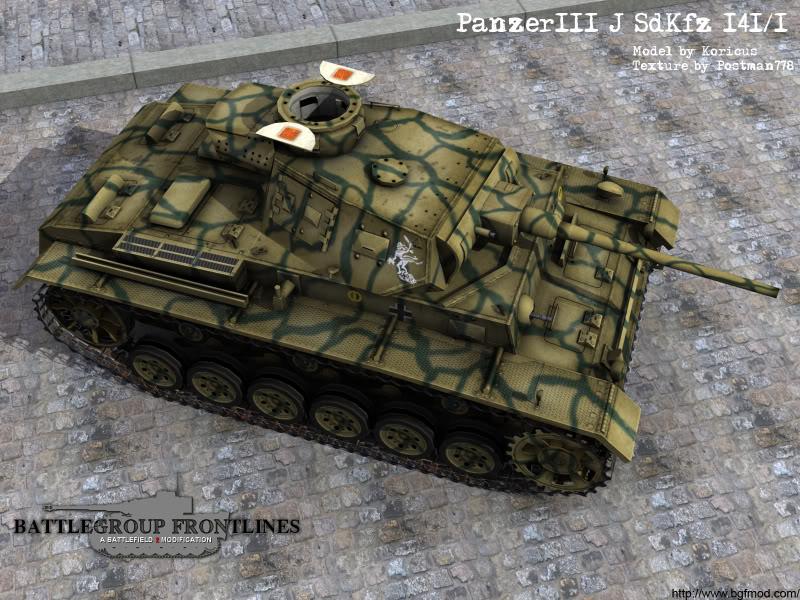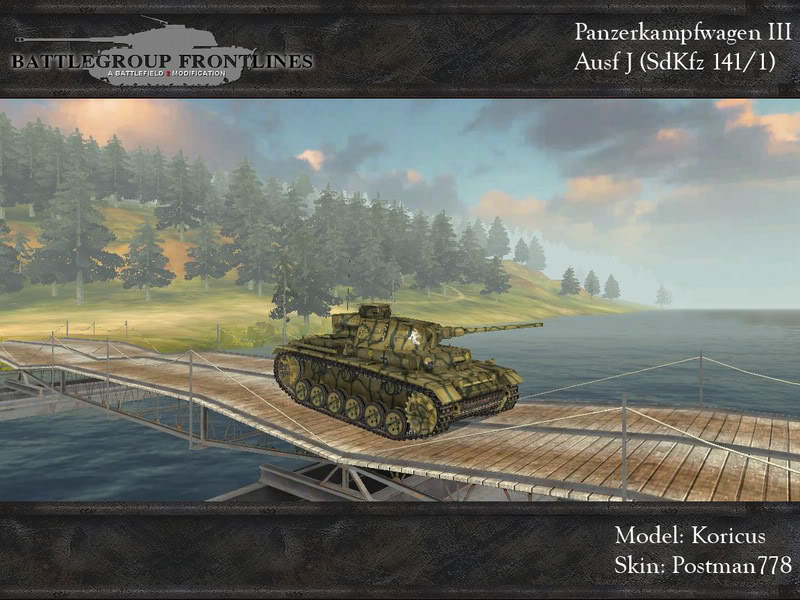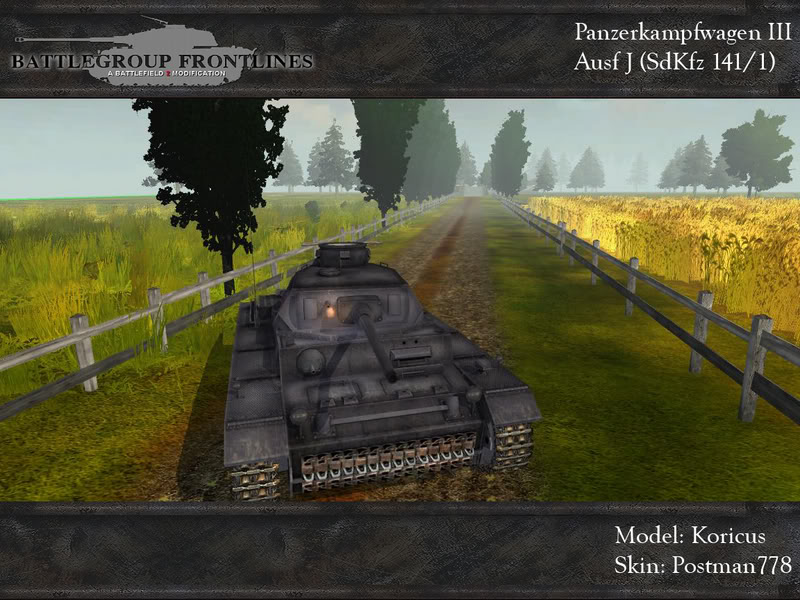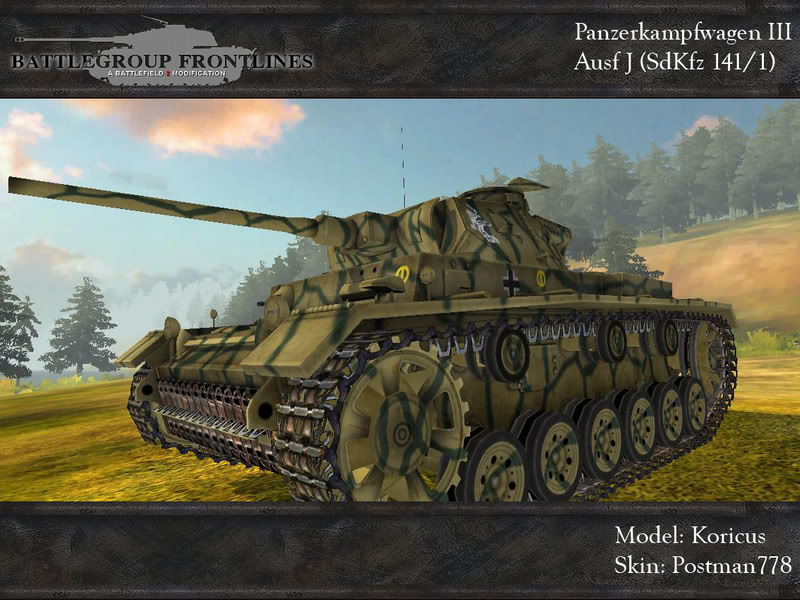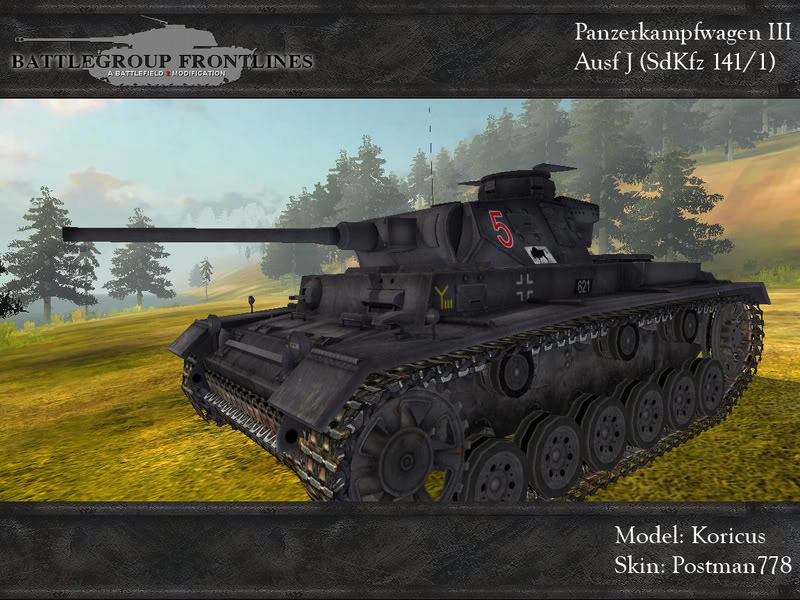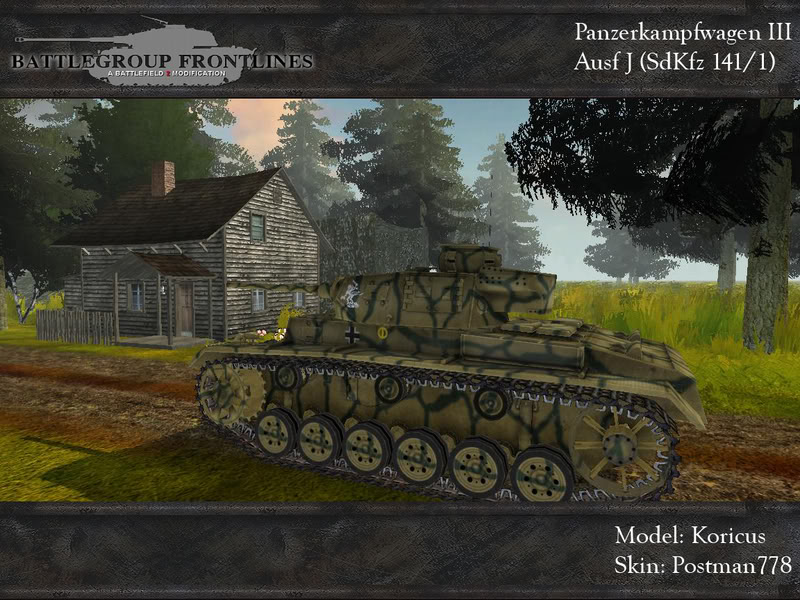The dust settled on the Eastern Front half a century ago, but in the distance you can still hear the sound of tank cannons firing from our Panzerkampfwagen III Ausf J. This late version Ausf. J (SdKfz 141/1) was modeled by Koricus and skinned by Postman778. The Panzer III was the main battle tank of the Panzer Divisions during the early years of the war before being replaced by the late model Panzer IV.
We are also currently seeking talented modders to join our team. We are currently interested in coders, mappers, and skinners. If you are interested in joining us on the Eastern Front, send us an email at job@bgfmod.com letting us know how you`d like to help.
Panzerkampfwagen III In 1934/5 Heinz Guderian envisioned two basic types of tank to act as the most common equipment for the future Panzer Divisions. The first was to be armed with an anti-tank gun and two machine guns and the second one was to be a support vehicle armed with a larger caliber gun. The first one eventually became known as Panzerkampfwagen III, which was to be a standard tank, for the three light companies of the tank battalion. The second one became known as Panzerkampfwagen IV. In 1935 development orders were placed based on the Waffenamt’s (Ordinance Department) specifications for a 15 ton fully tracked vehicle to be armed with an anti-tank gun and 2 machine guns were delivered to MAN, Daimler-Benz AG, Rheinmetall-Borsig and Krupp AG. To maintain secrecy the vehicle was to be known as ‘Zugfuehrerwagen’ (ZW) –Platoon Commander’s vehicle – it was designated Versuchkraftfahrzeug 619, Mittlerer Traktor (medium tractor) and 3.7cm Geschutz-Panzerwagen. The development of the Panzer III began with a dispute between the Waffenamt and the Inspector for Mechanized troops about the main armament – the Waffenamt had chosen and was happy with a 37mm gun while the Inspector wanted a 50mm gun, in the end the 37mm was chosen. This was partly because the army already had the 37mm Pak 35/36 L/45 anti-tank gun and so only one type of ammunition would need to be produced, however the turret and the turret ring were able to mount heavier guns when any upgrade was deemed necessary. The armor protection was to be heavier in the front than in the rear and it would have a top speed of 40km/h (24.85mph). It was to be manned by a crew of 5 who communicated through an intercom system which was the first to be fitted in a German Panzer and later became standard equipment on all later German tanks and proved to very effective when in combat. Trials were carried out on various prototypes from 1936 until 1937 on the testing grounds at Kummersdorf and Ulm which resulted in the Daimler Benz design being chosen for full scale production which started in early 1937 on the Waffenamt’s orders. After a few modifications in the initial production phase the first Panzer III Ausf A’s rolled of the production line in May 1937 and a total of 10 were produced by the end of the year (15 by some sources), however only 8 had any armament and they took part in the Anschluss with Austria on the 12th of March 1938 as well as in the Sudetenland in September 1938 and in Fall Weiß in 1939. The unarmed tanks were used for further testing. The Ausf A through to D was all pre-prototypes of the entire series which were produced only by Daimler-Benz and were unsuitable for large scale production although they were all improvements on the model before them. The Ausf E was the first of the series to be built on any scale with 96 being produced by the time production ended in October 1939.
By the time of the invasion of France the Panzer divisions had 381 Panzer III’s (Ausf E, F, G and H’s) in service of which 135 were lost during the Blitzkrieg on France and the Low Countries. With the Ausf G came the 50mm KwK 38 L/42 gun which replaced the 37mm KwK 35/36 L/46.5 as the main armament of the Panzer III. In March 1941 the Ausf J entered production at Daimler-Benz, MAN, Alkett, Henschel, Wegmann, MNH and MIAG and 2616 were produced by the time production stopped in July 1942. The Ausf J had significantly improved armor compared to its predecessors with a thickness range of 10-50mm (compared to 12 to 30mm for the previous versions). There were two versions of the Ausf J; the first was armed with the same 50mm Kwk38 L/42 as originally fitted to the Ausf G of which 1549 were produced between March 1941 and July 1942. The second version was armed with the more powerful 50mm KwK 38 L/60 and designated PzKptw III Ausf J/Sd.Kfz.141/1 (nicknamed Mark III Special by the British in North Africa) of which 1067 were produced between December 1941 and July 1942.
Specifications:
Panzerkampfwagen III Ausf J, SdKfz 141/1
Crew: 5 (Commander, gunner, loader, driver, radio operator)
Physical Characteristics
Weight: 27,557 lb (21.5 tons)/49,163 lb (23.9 tons)
Length (with gun): 20` 7" (6.28 m)/21` 1" (6.41 m)
Length (without gun): 17` 8" (5.52 m)
Height: 8` 2.5" (2.5 m)/9` 8" (2.51 m)
Width: 9` 8.25"(2.95 m)
Ground Clearance: 1` 2" (0.41 m)
Armament
Main Gun: 50 mm KwK 39 L/60
Machine Gun: 1 x 7.92 mm MG34 coaxial and 1 x 7.92 mm MG34 in the bow
Ammunition
Main: 84 Pzgr & Sprgr
Machine Gun: 2,700 Patr SmK
Armor thickness (mm)
Upper Front Hull: 50@9°
Lower Front Hull: 50@21°
Upper Hull Sides: 30@0°
Lower Hull Sides: 30@0°
Rear Hull: 50@10° and 15°
Hull Top: 17@75°-90°
Hull Bottom: 16@90°
Turret Front: 30@15° (Mantlet: 50@0°-45°)
Turret Sides: 30@25°
Turret Rear: 30@12°
Turret Top: 10@83°-90°
Engine: Maybach HL 120 TRM (300hp)
Max Speed: 24.9 mph (40 kph)
Cross Country: 11.2 mph (19 kph)
Road Radius: 109 miles (175 km)
Cross country Radius: 60.3 miles (97 km)
Number Built: 1067
Production Dates: December 1941 – July 1942
